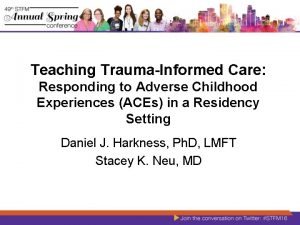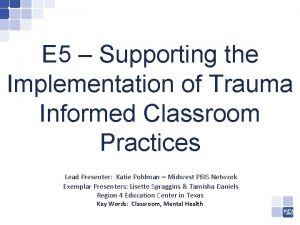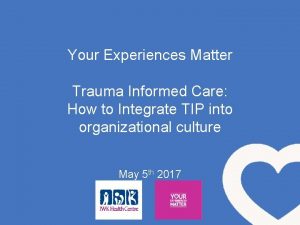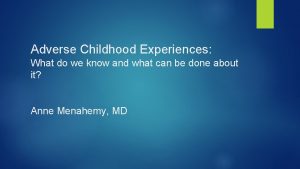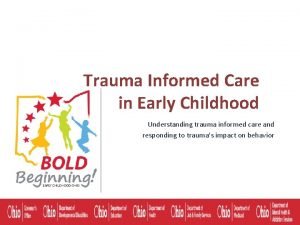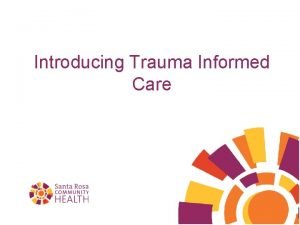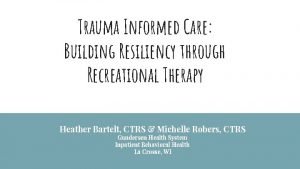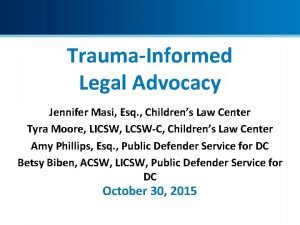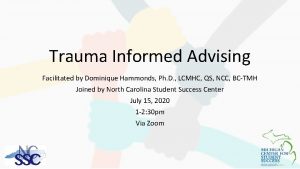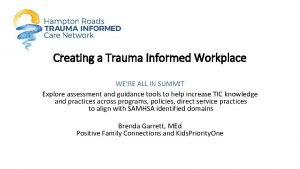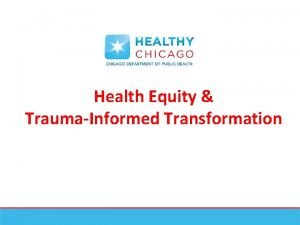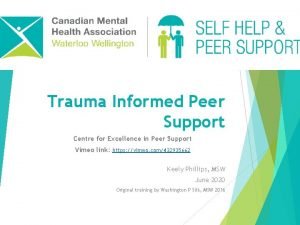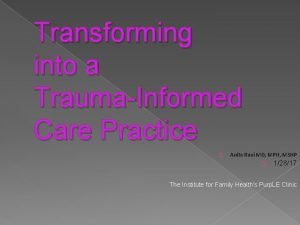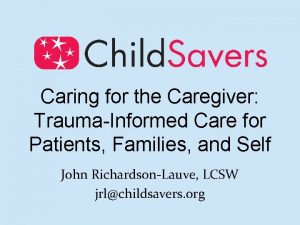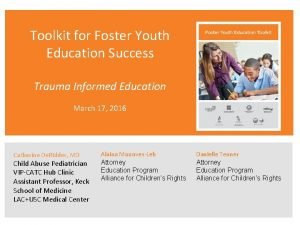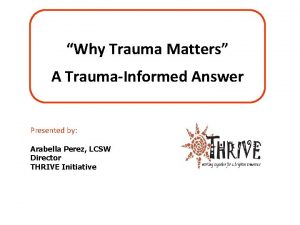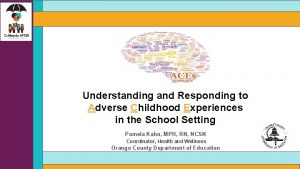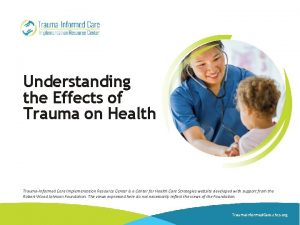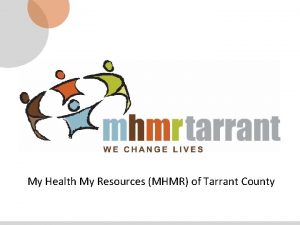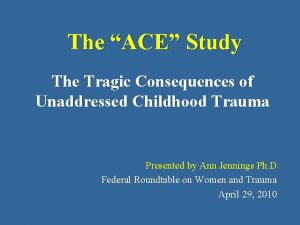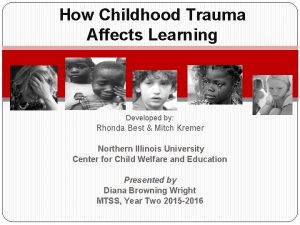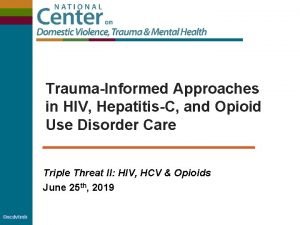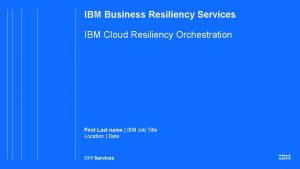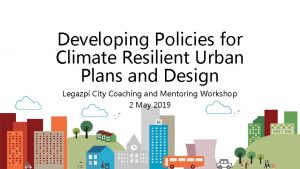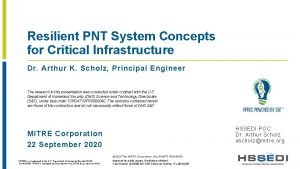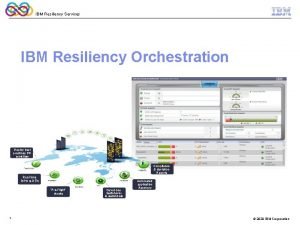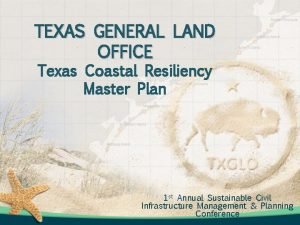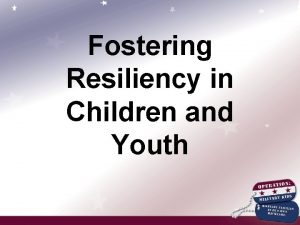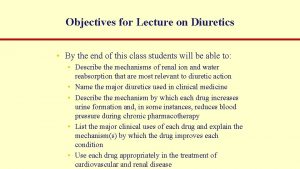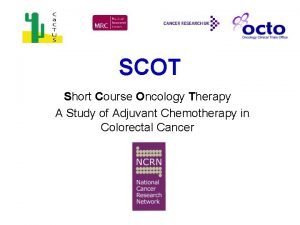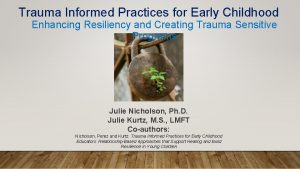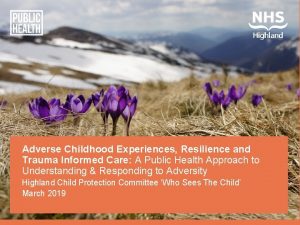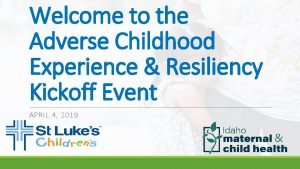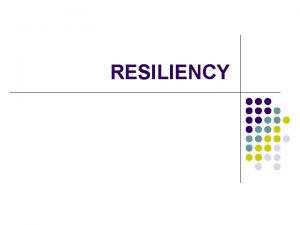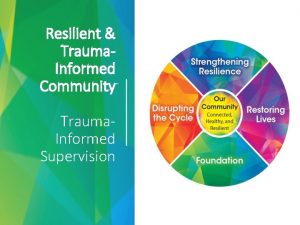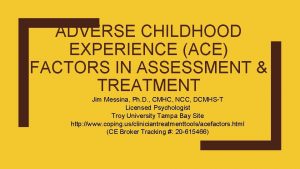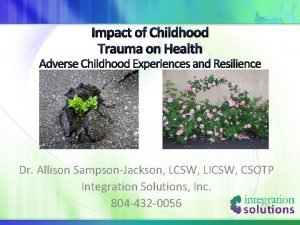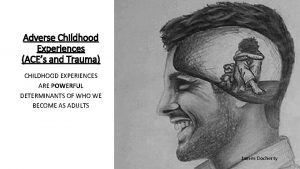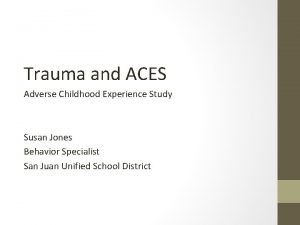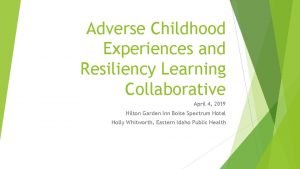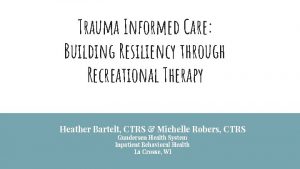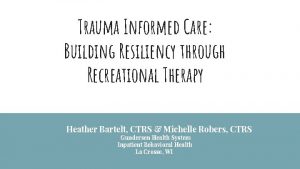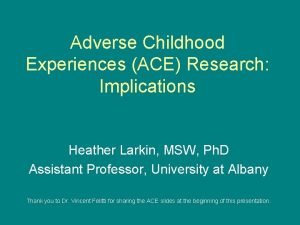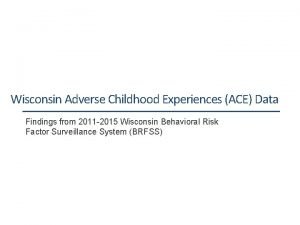Adverse Childhood Experience ACE Resiliency The Trauma Informed
















































- Slides: 48

Adverse Childhood Experience (ACE) & Resiliency The Trauma Informed Approach (The Theory of Everything) Matthew Doll, Ph. D Agnesian Health. Care

As promised…. . § …. will focus on the impact of mental health on business and how taking a Trauma Informed approach can help organizations improve their response to mental health issues such as anxiety, depression and suicidal ideation as well as increase productivity and decrease absences.

Business Losses From Mental Illness § A survey of 34, 622 employees at 10 companies revealed all costly health conditions (as a sum of medical costs and selfreported presenteeism and absenteeism). Among these, depression ranked first and anxiety ranked fifth. 9 § Workplace absenteeism related to mental disorders accounts for an estimated 7% of global payroll across all organizations, more than any other disorder. 11 § The burden associated with mental disorders is consistently found to be greater than that of physical disorders, comparing the direct (medical/pharmaceutical) costs and indirect (absenteeism/presenteeism) costs of each disorder. s, more than any other disorder. 11 13

Absenteeism & Presenteeism § Among all productivity losses, 81 per cent of lost productivity time (LPT) is due to presenteeism. 19 § A study of employee assistance programs (EAPs) showed that 80 percent of the costs of lost productivity are associated with presenteeism while only 20 percent are associated with absenteeism. 20 § Presenteeism is an indirect cost that refers to an illnessrelated reduction in work productivity — disorders of the working wounded. 17

Why This is Important…$$$$ § Many studies have concluded that the indirect costs of mental health disorders – particularly lost productivity — exceed companies’ spending on direct costs, such as health insurance contributions and pharmacy expenses. § A 2014 report stated that for every dollar invested in creating a mentally healthy workplace, $2. 30 is generated in benefits to the company. 74 § Employees whose mental disorders are being attended to provide better customer service, and experience more favorable co-worker interactions, higher productivity, and less healthcare-related expense. 70

What About Treatment? § What type of coverage does your plan offer for mental health? § Session limits, service restrictions, Pre-existing conditions, true parity, deductibles, affected lives reports……. § Most employees with depressive disorder are not being treated. In fact, for every single employee being treated, 2. 3 (70 percent) are receiving no treatment. 35 § More than one-half the costs associated with anxiety disorders were spent on non-psychiatric medical treatment.

Treatment Works § Evidence-based treatments are effective in reducing symptoms of common workplace mental disorders (depression, anxiety) in up to 75% of individuals. 59 § Research shows that the cost of depression treatment is fully offset by the savings due to absenteeism alone. § QPR, Responding to a Mental Health Crisis, Mental Health Training (only 15% of managers are trained to recognize mental health issues)

Strategic Stigma Change § Studies document that stigma — widely-shared negative stereotypes about the causes and effects of mental illness — is the single greatest barrier to treating mental illness and lowering costs. 2 § Persons with mental illness who return to work have experienced harassment, intimidation, and teasing to the point of having to resign or be dismissed from their job. Even the fear of the prospect of these behaviors happening prevents individuals with mental illness from returning, or applying for a job. 44 § “CEOs Against Stigma” Campaign 1 The role of the CEO is critical. 2 Education and awareness among managers are also key ingredients. 3 Exposure to the personal dimension is key to fighting workplace stigma. Presentations and conversations with people in recovery who have first-hand experience is the proven method for reducing stigma. 58

Trauma Informed: A Strength-Based Model § Not asking “What’s wrong with you? ” but asking, “What happened to you? ” § Helps reframe people’s history so they know they were not born bad, that they are not responsible for their childhoods, and that they can have hope to change their lives and their children’s lives. § Personal responsibility with the power of self-understanding.

Why this Matters Now And for the Future https: //www. albertafamilywellness. org/resources/video/howbrains-are-built-core-story-of-brain-development (4 min) Where would we be now if we had been growing the next generation of workers 20 years ago? Which metric would not have been improved? Any? Shall we begin?


The Five Parts of ACE’s Science § ACE surveys - who, how many, with what consequences. § Toxic stress effects on the brain § Toxic stress effects on the body § Toxic stress passed from generation to generation § Resilience research

Trauma Derails Development § Exposure to trauma causes the brain to develop in a way that will help the child survive in a dangerous world. § Children with traumatic histories often operate within “survival of the moment. ” § Higher order brain functions are temporarily put on hold. § Verbal encoding may be put on hold. § Actions and responses are generated at lower levels of the brain (e. g. limbic system). § Limbic system increases heart rate and blood pressure to increase flow to muscles, so blood flow selectively diverted to parts of the body necessary to survival.

Stunning difference between a brain with proper stimulation and one that has been deprived. - Bruce Perry, Baylor College of Medicine

Relationships are the Basis of a Child's Stress Response System

Relationships are the Basis of a Child's Stress Response System Adapted from B. Perry, MD, Ph. D. (2009)

Put Simply… § The pattern of fear, threat, unpredictability, frustration, chaos, hunger and pain overstimulates the brain leading the child to develop a high-stress pattern. § Can be mitigated by individual difference in resiliency, supportive relationships. § Many adults continue to struggle unrecognized/untreated.

The Invisible Suitcase Trauma shapes beliefs and experiences § About ourselves § About those who care for us § About those we care for § About the world we see § “Triggers”…. hidden signals for stress response

Attachment § Earliest relationships critical for capacity to self-regulate. § Perspective taking - 10 out of 10 children securely attached to mothers that can do this, versus one out of 17 that can’t. § Still Face Experiment (2: 49) https: //www. youtube. com/watch? v=apz. XGEb. Zht 0

Attachment, cont. § Neglectful and traumatic early relationships set up a person to respond with dysregulation when “triggered” in subsequent relationships. § 60 percent of the general population is thought to have disturbed attachment. § Remember - we can help each other here! Model and act with compassion. § Grounding techniques – focus on present….


Burden dis/ease, Earlyof. Death distress, criminalization, Coping stigmatizaton Allostatic Load, Disrupted Neurological Development Complex Trauma/ ACE Race/Social Conditions/ Local Context Generational Embodiment/Historical Trauma





Therefore… We need to presume the individuals we work with (and ourselves) have a history of traumatic stress and exercise “universal precautions” by creating systems that are trauma informed. (Hodas, 2005 – modified a bit by me…)



Paper Tigers (2: 11) https: //www. youtube. com/watch? v=i. V 3 wz. Uh. JSKs § Why the Title? § Workplace and School setting similarities? § “Unemployable” percent in our community? § 2/3 of our age eligible youth are ‘unfit to serve” in the military….

Other Factors Influencing Stress Sources of Resilience Temperament Social-emotional supports Learned social-emotional skills Caregiver response Other Vulnerabilities Temperament Delays in development Limited social-emotional supports AAP, Helping Foster and Adoptive Families Cope with Trauma, 2013

Moving from Shame and Blame to Understanding and Support §How do we as HR professionals talk to someone with anxiety, depression, etc… ? §How can we put ourselves in their shoes, so to speak? §What are some accommodations we might consider? §What is treatment like? §What are side affects from medications?

Resiliency, Prevention, Empowerment § How to go about changing our process of coaching associates and corrective action as it relates to knowing our associate's ACE scores/trauma history. § Should we be treating associates uniquely because we may know they have a higher level of trauma in their past? § What is the impact on Leadership and Associate Engagement?

De-escalation techniques that may help resolve a crisis: § Keep your voice calm § Avoid overreacting § Listen to the person § Don’t argue or try to reason with the person § Express support and concern § Avoid continuous eye contact § Ask how you can help § Keep stimulation level low § Move slowly § Offer options instead of trying to take control § Avoid touching the person unless you ask permission § Be patient § Gently announce actions before initiating them § Give the person space

What We Want To Do § When people start escalating or display inappropriate behaviors, be empathetic, be calm, show care and concern. § We want to ask questions - but not what we sometimes do, “Look at Henry, there he goes with his old tricks again. ” § We want to ask: “What might have happened that is triggering for him? What might we not be doing that could support him? ”

Workplace Support Makes A Difference § Social support has been consistently shown to ameliorate the negative effects of depression. 66 § A key component is supervisor and co-worker support. 67 § Studies have shown that the little things matter when dealing with depressed individuals and that benefits may be gained simply by increasing the number of weekly reminders, developing daily schedules and routines, and having an increased number of follow-ups regarding work performed. 68 § Moving employees from a high stress level to a moderate stress level resulted in a 7. 4% drop in absenteeism. § Moving employees from a high stress level to a low stress level resulted in a 9. 4% improvement in presenteeism. 69

Key Factors For Stay-At-Work And Return. To-Work Success: § Solid partnerships § Communication with co-workers and supervisor § Positive co-worker and supervisor relationships § Resources and supports at the individual level § Long-term investment from healthcare providers § Workplace structures to prevent mental illness § Involvement of EAPs in stay-at-work interventions § Employee education on behavioral health issues § Job modifications: Duties, Work location, Hours of work § Behavioral Health screenings § Choice of carrier with a proven record for managing absence and disability. 71 72 73


Resources at Agnesian Health. Care Wellness…. . Integrated care The Zone & RMC Wellness Center Spiritual Care Services Behavioral Health Services Employee Assistance Program Health Resource Center at St. Agnes Hospital § § § Yoga classes Mindfulness classes Meditation classes Cooking classes And more!

Time to Think About Self-Care § Own ACE score § Vicarious trauma § Have to care for self when caring for others § Belly breathing, four square, lazy 8, Breath 2 Relax…. § Safe place image § Laugh…. a lot!

Current State § Community interest: Agnesian Health. Care Foundation grant to support www. csifdl. org (FDLSD, NFDLSD, Law Enforcement, Department of Social Services, Fond du Lac County, AHC, AMG, …. ) § Business Interest: FABHO’s Larry Richardson is leading SPROUT § Reaching out to AC, area Businesses…. YOU! § Communities that have become trauma informed have demonstrated savings in the billions! § Communities have had young adults return to raise their children because they felt the “love” as kids.

From 1994 to 2012, Washington State supported use of a self-healing model in 42 communities.

Show me the data…… § Communities using the model for eight or more years reduced the rates of seven major social problems: child abuse and neglect, family violence, youth substance abuse, dropping out of school, teen pregnancy and youth suicide. § Per-year avoided caseload costs in child welfare, juvenile justice and public medical costs associated with births to teen mothers were calculated to be over $601 million, an average of $120 million per year, for a public investment of $3. 4 million per year.

We need Business (HR) At the Table § What would it be like now to have joined together and unified our efforts to become a Trauma Informed Community? § What can you do to forward the effort to become a Trauma Informed Workplace? § How can you advocate for your company to fully support mental health services and create a mentally healthy workplace? § Can you leverage your companies resources to support WWW. CSIFDL. ORG? § Together we can have a healthier, prosperous, safer community with long term sustainable growth. § Visit www. csifdl. org and get involved in any of the 5 elements; Violence Prevention, ATODA, Social/Emotional Support, Early Childhood, Adult/Senior Services

The Goal The entire community… …integrates trauma-informed/resiliencebuilding practices… …based on ACEs science. Root Cause, Lean Six Sigma….

Epigenics and Bob Marley https: //m. youtube. com/watch? v=u. HAs 0 Qk. J 3 d. Q 1: 22 -2: 39 1: 17 min

Discussion & Questions

Resources § www. CSIFDL. org - Working for safe and healthy schools and communities in Fond du Lac County. § SAMHSA’s Concept of Trauma and Guidance for a Trauma-Informed Approach - How an organization, system or service sector can become trauma informed. § www. ACEs. Connection. com – A social network for people who are implementing trauma-informed and resilience-building practices based on ACEs research. § ACEs. Too. High. com - A news site for the general public. § The CDC-Kaiser Permanente ACE Study - The official ACE Study site, provided by the CDC. § The Center on the Developing Child at Harvard University – Reports, tools and videos about the neurobiology of toxic stress and resilience. § “Bad for Business” Prepared by NAMI Massachusetts.
 Family enhancement center
Family enhancement center Trauma-informed care cheat sheet
Trauma-informed care cheat sheet Trauma informed physical environment
Trauma informed physical environment Trauma informed practice
Trauma informed practice 4 r's trauma informed care
4 r's trauma informed care 4 r's trauma informed care
4 r's trauma informed care Tina champagne trauma informed care
Tina champagne trauma informed care Trauma-informed care activities for staff
Trauma-informed care activities for staff Trauma-informed care cheat sheet
Trauma-informed care cheat sheet Jennifer masi
Jennifer masi Lgbtq trauma informed care
Lgbtq trauma informed care Trauma informed advising
Trauma informed advising Trauma informed workplace
Trauma informed workplace Trauma informed practice
Trauma informed practice Kobtion
Kobtion 4 r's trauma informed care
4 r's trauma informed care Acessexual
Acessexual Trauma-informed questions for clients
Trauma-informed questions for clients Trauma informed care for foster youth
Trauma informed care for foster youth Schoolsworkpro
Schoolsworkpro Adverse childhood experiences study
Adverse childhood experiences study Slidetodoc.com
Slidetodoc.com Adverse childhood experiences study
Adverse childhood experiences study Mhmr of tarrant county
Mhmr of tarrant county Ace test score interpretation
Ace test score interpretation Childhood trauma discussion questions
Childhood trauma discussion questions Gabriela zapata alma
Gabriela zapata alma Early childhood
Early childhood The daily nightfall prayer that rizal used to participate
The daily nightfall prayer that rizal used to participate Experience expectant vs experience dependent
Experience expectant vs experience dependent Early experience vs later experience debate
Early experience vs later experience debate Direct and indirect experience
Direct and indirect experience Ibm resiliency orchestration
Ibm resiliency orchestration Ibm i high availability
Ibm i high availability Nyc climate resiliency design guidelines
Nyc climate resiliency design guidelines Business continuity and resiliency services
Business continuity and resiliency services Sgip equity resiliency program
Sgip equity resiliency program Resilient pnt
Resilient pnt Ibm resiliency services
Ibm resiliency services Texas glo gis
Texas glo gis Ibm geographically dispersed resiliency for power systems
Ibm geographically dispersed resiliency for power systems The resiliency wheel
The resiliency wheel Alpha-adrenergic antagonist
Alpha-adrenergic antagonist 5.2 driving in adverse conditions assignment
5.2 driving in adverse conditions assignment Loop diuretics adverse effects
Loop diuretics adverse effects Adverse reaction definition
Adverse reaction definition Tools to help solve adverse selection problems
Tools to help solve adverse selection problems Sentinel report meaning
Sentinel report meaning Adverse
Adverse

